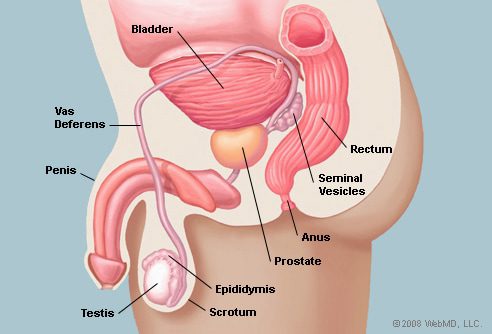Contents
- The prostate
- The prostate develops from childhood
- The prostate participates in the production of sperm
- The prostate produces fluid that partly drains into the urine
- The prostate is a pre-ejaculatory sensation zone
- The prostate receives fluid from the seminal vesicles
- The prostate contracts during ejaculation
- The prostate is aging
- The prostate, a source of pleasure?
The prostate
The prostate is a gland that only men have. It is part of the genitourinary system. It has about the shape and size of a large chestnut which would be crossed from top to bottom by a tube: the urethra, tube which allows urine to exit the bladder. It is an important organ for men, their sexuality and fertility as well as for the proper functioning of their urinary tract.
The prostate develops from childhood
This sex gland is very small in a child, then it grows at the time of puberty, under the effect of the sex hormones produced by the testes and the adrenal glands. She eventually reaches a weight of about 14 to 20 grams. It then becomes an adult and functional prostate.
The prostate participates in the production of sperm
The prostate is an exocrine gland, which means that it makes fluid that goes outside the body. This liquid is prostatic fluid.
If the semen contains sperm, and it also contains prostatic fluid. This liquid makes up about 30% of semen at the time of ejaculation. It is important for the sperm to be fertile.
The prostate produces fluid that partly drains into the urine
A small part of the fluid made by the prostate, prostatic fluid is excreted regularly in the urine, at the rate of about 0,5 to 2 ml each day. It cannot be seen with the naked eye, as it is diluted in the urine!
The prostate is a pre-ejaculatory sensation zone
Before the actual ejaculation, so before the expulsion of the semen, the tube which crosses the prostate (the prostatic urethra) dilates. This is due to the fact that sperm accumulates there before being exteriorized by the body.
This phenomenon contributes to the particular sensation announcing to the man concerned that his ejaculation is imminent.
The prostate receives fluid from the seminal vesicles
The two seminal vesicles (which every man has) are exocrine glands like the prostate: they produce a liquid which is evacuated outside the body. This fluid is seminal fluid, one of the components of semen. It is inside the prostate, in the area called the prostatic urethra that the fluids from the seminal vesicles and the prostate are mixed, and this, just before ejaculation.
The prostate contracts during ejaculation
At the time of ejaculation, the smooth muscles in the prostate contract. It is these contractions, together with the contractions of other organs, that produce the force of ejaculation. These smooth muscles work on an automatic and involuntary basis. It is therefore impossible to control them, so to decide when we can trigger ejaculation. The contractions are rhythmic, and there are several.
The prostate is aging
Over the years, the prostate ages … like the whole body. She tends to make less prostatic fluid, which leads to a decrease in semen volume, she tends to increase in volume, which can press on the urethra and cause urinary problems, and her muscles tend to become less toned , resulting in a decrease in the force of ejaculation. All of these phenomena are normal, it is only when they are exaggerated that they become bothersome, especially when the prostate gets too big.
The prostate, a source of pleasure?
Massaging the prostate is likely to trigger orgasms. However, it is not easy to approach the prostate, which is an internal organ.
The area of the prostate is examined by doctors with a digital rectal exam to look for an increase in size or cancer of the prostate. the doctor proceeds by inserting a finger protected by a finger cot, in order to touch the prostate as closely as possible.
The anal route is therefore the most suitable for touching and massaging the prostate, whether for a medical examination, or in order to provoke arousal and sexual pleasure.
Also some men experience orgasms through anal sex, whether it is digital stimulation (self-stimulation or stimulation by the partner) or penile (in the case of relationships between men).
Writing : Dr. Catherine Solano, September 2015 |










